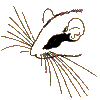

Dormouse Talk Instructions and Archives
How to Subscribe
Compliled and Edited by Werner
Haberl
Number of recipients: > 130
Please share your thoughts and answers with the rest of the group!
Replies to the following messages should be sent as CC-Mail to dormouse@glirarium.org
Dear Kristof,
If you want to know what happens when you don't give any food to your captive dormouse, then read my paper:
Vogel P. (1997): Hibernation of recently captured Muscardinus, Eliomys and Myoxus: a comparative study. Nat. Croat. 6: 217-231.
In fact, Eliomys and Muscardinus make torpor with food in the cage, even at 18°C. Myoxus is totally different. Brought from nature to the lab, kept at 5°C in a isolated room, they don't want to hibernate. If you give just at the onset a high quantity of food, they first remain at euthermia during a week or two. When the food is depleted, they pass to a phase with daily torpor, but each night they wake up and look for food. Then they enter "hibernation" without waking up and you think now it is ok. But if you control the body weight you will see that they have lost the fat reserve (from 180 g down to 90 g) and are living now probably on proteins. Some days later they will be dead with a weight of 70 g.
I think, these animals are very stress sensitive. However, in literature you find reports of people hibernating them in a fridge. So I raised up two pups with the milk bottle two years ago. They are living now in a big outside enclosure. They are no longer tame, but they are not stressed if I enter in the enclosure and if I bring food and open the nestboxes. This winter, they were often in torpor (e.g. this morning) and made some real hibernation bouts. However, they do not behave as in nature, going under the soil in September and coming back in May or even later.
In the above mentioned publication, I made also a comparison of the food preferences between the 3 dormouse species. I was astonished that my Glis did not accept any meet, eggs or insects. In many publications they are described as voracious bird, egg and insect eaters. I tried however always a bit with mealworms, and last autumn, they started to eat mealworms, at least, the mealworms disappeared within some days. So I concluded that it is a question of habituation. But in February, I found a dead shrew in the water dish of the dormice: it was fallen down >from the mealworm dish! Since that day, I put the mealworm dish in a suspended dormouse feeder. Now, two month later, this dish is still full of mealworms! As a conclusion, my Glis (and Muscardinus) do not eat mealworms! In contrast, Eliomys and Dryomys eat huge quantities of these insects.
If you want a copy of the above mentioned paper, then give me your post mail address.
Best wishes,
Peter
Prof. Dr. Peter VOGEL
Institut d'Ecologie - Zoologie et Ecologie Animale
Bâtiment de Biologie
Université de Lausanne
CH 1015 Lausanne
Switzerland
Dear Glis-friends,
There is a comprehensive article about the relationship between man and gliridae from the 2° Conf. on Dormice:
Carpaneto G.M. & M.Cristaldi, 1995. Dormice and Man: a review of past and present relations: Hystrix, (n.s.) 6 (1-2): 303-330.
with pictures and drawings of gliraria
best wishes Dino
Dino Scaravelli
Riserva Naturale Orientata di Onferno & Museo Naturalistico
Comune di Gemmano
piazza Roma 1, I - 47855 Gemmano (RN)
www.regione.emilia-romagna.it/parchi/onferno/
Dear Collegues,
In May I'm planning to start research on the edible dormouse. Hence I need every information about effective bait used in live-trapping those shy animals (and other dormouse species). I'd also appreciate any details on marking juvenile dormice (for adults I'm going to use ear-tattooing).Any suggestions on trapping techniques are welcome, too (e.g. optimal height/part of a tree for placing traps). Thank you in advance.
Best regards,
Michal Scinski
Department of Behavioural
and Evolutionary Ecology,
Institute of Ecology PAS,
Dziekanow Lesny
Poland
I am sorry for this question - do anybody know, what is with proceedings from Turkish conference in 1999? Will be it published?
regards-
Alek
Dr Alek Rachwald
Forest Research Institute, Ecology & Nature Protection Dept.
Bitwy Warszawskiej St. 00-973 Warszawa, Poland, tl 22 7150410
Bertolino, S., C. Viano, I. Currado. 2001. Population dynamics, breeding patterns and spatial use of the garden dormouse (Eliomys quercinus) in an Alpine habitat. J. Zool., Lond. 253: 513-521.
Number of Visitors (Date: 5 September 2000): >1380 Number of recipients: >120
Dormouse Talk Instructions: ... how to join, post & leave
Dr. Werner Haberl
Editor of DORMOUSE TALK & SHREW TALK
Chair, Insectivore Specialist Group
Species Survival Commission
IUCN - The World Conservation Union
Hamburgerstr. 11, A-1050 Vienna, Austria
Email: dormouse@glirarium.org
The Dormouse Hollow: www.glirarium.org/dormouse
The Shrew Shrine: members.vienna.at/shrew
IUCN / ITSES: members.vienna.at/shrew/itses.html
Back to Dormouse Talk Archives / Index